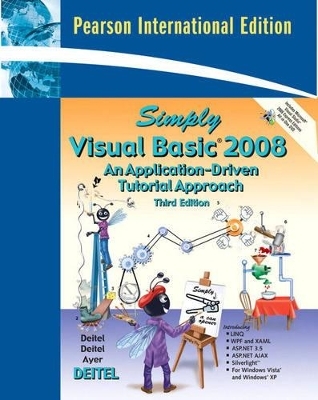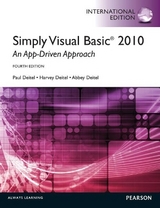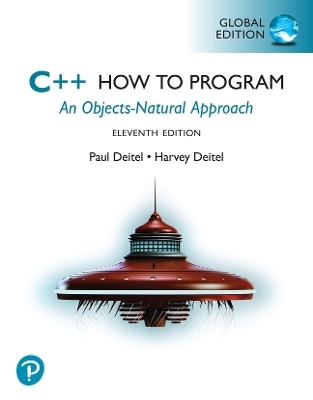
Simply Visual Basic 2008
Pearson
978-0-13-715647-4 (ISBN)
- Titel erscheint in neuer Auflage
- Artikel merken
Merging the concept of a lab manual with that of a conventional textbook, the Deitels have crafted an innovative approach that enables students to learn programming while having a mentor-like book by their side. This best-seller blends the Deitel™ signature Live-Code™ Approach with their Application-Driven™ methodology. Students learn programming and Visual Basic by working through a set of applications. Each tutorial builds upon previously learned concepts while learning new ones, An abundance of self assessment exercises are available at the end of most chapters to reinforce key ideas.
This approach makes it possible to cover a wealth of programming constructs within the Visual Basic 2008 environment. Key topics include Language Integrated Query (LINQ), Visual Programming, Framework Class Library (FCL), Controls (Buttons, TextBoxes, ListBoxes, Timers, ComboBoxes, RadioButtons, Menus, Dialogs), Event Handling, Debugger, Algorithms, Control Structures, Methods, Random-Number Generation, Arrays, Classes, Objects, Collections, Mouse & Keyboard Event Handling, Strings, Files, Database, Graphics, Multimedia, GUI Design and Web applications. Deitel accomplishes this by making highly technical topics as simple as possible. The Third Edition is fully updated for Visual Studio 2008, Visual Basic 2008 and .NET 3.5.
Paul J. Deitel, CEO and Chief Technical Officer of Deitel & Associates, Inc., is a graduate of MIT’s Sloan School of Management, where he studied Information Technology. He holds the Java Certified Programmer and Java Certified Developer certifications, and has been designated by Sun Microsystems as a Java Champion. Through Deitel & Associates, Inc., he has delivered Java, C, C++, C# and Visual Basic courses to industry clients, including IBM, Sun Microsystems, Dell, Lucent Technologies, Fidelity, NASA at the Kennedy Space Center, the National Severe Storm Laboratory, White Sands Missile Range, Rogue Wave Software, Boeing, Stratus, Cambridge Technology Partners, Open Environment Corporation, One Wave, Hyperion Software, Adra Systems, Entergy, CableData Systems, Nortel Networks, Puma, iRobot, Invensys and many more. He has also lectured on Java and C++ for the Boston Chapter of the Association for Computing Machinery. He and his father, Dr. Harvey M. Deitel, are the world’s best-selling programming language textbook authors. Dr. Harvey M. Deitel, Chairman and Chief Strategy Officer of Deitel & Associates, Inc., has 45 years of academic and industry experience in the computer field. Dr. Deitel earned B.S. and M.S. degrees from the MIT and a Ph.D. from Boston University. He has 20 years of college teaching experience, including earning tenure and serving as the Chairman of the Computer Science Department at Boston College before founding Deitel & Associates, Inc., with his son, Paul J. Deitel. He and Paul are the co-authors of several dozen books and multimedia packages and they are writing many more. With translations published in Japanese, German, Russian, Spanish, Traditional Chinese, Simplified Chinese, Korean, French, Polish, Italian, Portuguese, Greek, Urdu and Turkish, the Deitels’ texts have earned international recognition. Dr. Deitel has delivered hundreds of professional seminars to major corporations, academic institutions, government organizations and the military.
[IMPORTANT: See www.deitel.com/books/SimplyVB2008/ for the latest table of contents.]
1 Drawing Application
Introducing Computers, the Internet and Visual Basic
1.1 What Is a Computer?
1.2 Computer Organization
1.3 Machine Languages, Assembly Languages and High-Level Languages
1.4 Visual Basic
1.5 Other High-Level Languages
1.6 Structured Programming
1.7 Key Software Trend: Object Technology
1.8 The Internet and the World Wide Web
1.9 Introduction to Microsoft .NET
1.10 Test-Driving the Visual Basic Drawing Application
1.11 Web Resources
1.12 Wrap-Up
2 Welcome Application
Introducing the Visual Basic 2008 Express Edition IDE
2.1 Test-Driving the Welcome Application
2.2 Overview of the Visual Basic 2008 Express Edition IDE
2.3 Creating a Project for the Welcome Application
2.4 Menu Bar and Toolbar
2.5 Visual Basic 2008 Express Edition IDE Windows
2.6 Auto-Hide
2.7 Using Help
2.8 Saving and Closing Projects in Visual Basic
2.9 Web Resources
2.10 Wrap-Up
3 Welcome Application
Introduction to Visual Programming
3.1 Test-Driving the Welcome Application
3.2 Constructing the Welcome Application
3.3 Objects Used in the Welcome Application
3.4 Wrap-Up
4 Designing the Inventory Application
Introducing TextBoxes and Buttons
4.1 Test-Driving the Inventory Application
4.2 Constructing the Inventory Application
4.3 Adding Labels to the Inventory Application
4.4 Adding TextBoxes and a Button to the Form
4.5 Wrap-Up
5 Completing the Inventory Application
Introducing Programming
5.1 Test-Driving the Inventory Application
5.2 Introduction to Visual Basic Code
5.3 Inserting an Event Handler
5.4 Performing a Calculation and Displaying the Result
5.5 Using the Debugger: Syntax Errors
5.6 Wrap-Up
6 Enhancing the Inventory Application
Introducing Variables, Memory Concepts and Arithmetic
6.1 Test-Driving the Enhanced Inventory Application
6.2 Variables
6.3 Handling the TextChanged Event
6.4 Memory Concepts
6.5 Arithmetic
6.6 Using the Debugger: Breakpoints
6.7 Internet and Web Resources
6.8 Wrap-Up
7 Wage Calculator Application
Introducing Algorithms, Pseudocode and Program Control
7.1 Test-Driving the Wage Calculator Application
7.2 Algorithms
7.3 Pseudocode
7.4 Control Structures
7.5 If…Then Selection Statement
7.6 If…Then…Else Selection Statement
7.7 Constructing the Wage Calculator Application
7.8 Assignment Operators
7.9 Formatting Text
7.10 Using the Debugger: The Watch Window
7.11 Wrap-Up
8 Dental Payment Application
Introducing CheckBoxes and Message Dialogs
8.1 Test-Driving the Dental Payment Application
8.2 Designing the Dental Payment Application
8.3 Using CheckBoxes
8.4 Using a Dialog to Display a Message
8.5 Logical Operators
8.6 Designer-Generated Code
8.7 Wrap-Up
9 Car Payment Calculator Application
Introducing the Do While…Loop and Do Until…Loop
Repetition Statements
9.1 Test-Driving the Car Payment Calculator Application
9.2 Do While…Loop Repetition Statement
9.3 Do Until…Loop Repetition Statement
9.4 Constructing the Car Payment Calculator Application
9.5 Wrap-Up
10 Class Average Application
Introducing the Do…Loop While and Do…Loop Until
Repetition Statements
10.1 Test-Driving the Class Average Application
10.2 Do…Loop While Repetition Statement
10.3 Do…Loop Until Repetition Statement
10.4 Creating the Class Average Application
10.5 Wrap-Up
11 Interest Calculator Application
Introducing the For…Next Repetition Statement
11.1 Test-Driving the Interest Calculator Application
11.2 Essentials of Counter-Controlled Repetition
11.3 Introducing the For…Next Repetition Statement
11.4 Examples Using the For…Next Statement
11.5 Constructing the Interest Calculator Application
11.6 Wrap-Up
12 Security Panel Application
Introducing the Select Case Multiple-Selection Statement
12.1 Test-Driving the Security Panel Application
12.2 Introducing the Select Case Multiple-Selection Statement
12.3 Constructing the Security Panel Application
12.4 Wrap-Up
13 Enhancing the Wage Calculator Application
Introducing Function Procedures and Sub Procedures
13.1 Test-Driving the Enhanced Wage Calculator Application
13.2 Classes and Procedures
13.3 Function Procedures
13.4 Using Sub Procedures in the Wage Calculator Application
13.5 Using the Debugger: Debug Toolbar
13.6 Wrap-Up
14 Shipping Time Application
Using Dates and Timers 289
14.1 Test-Driving the Shipping Time Application
14.2 Date Variables
14.3 Building the Shipping Time Application: Design Elements
14.4 Creating the Shipping Time Application: Inserting Code
14.5 Wrap-Up
15 Fund Raiser Application
Introducing Scope, Pass-by-Reference and Option Strict
15.1 Test-Driving the Fund Raiser Application
15.2 Constructing the Fund Raiser Application
15.3 Passing Arguments: Pass-by-Value vs. Pass-by-Reference
15.4 Option Strict
15.5 Wrap-Up
16 Craps Game Application
Introducing Random-Number Generation
16.1 Test-Driving the Craps Game Application
16.2 Random-Number Generation
16.3 Using Enumerations in the Craps Game Application
16.4 Using Random Numbers in the Craps Game Application
16.5 Wrap-Up
17 Flag Quiz Application
Introducing One-Dimensional Arrays and ComboBoxes
17.1 Test-Driving the Flag Quiz Application
17.2 Introducing Arrays
17.3 Declaring and Allocating Arrays
17.4 Constructing the Flag Quiz Application
17.5 Sorting Arrays
17.6 Wrap-Up
18 Student Grades Application
Introducing Two-Dimensional Arrays and RadioButtons
18.1 Test-Driving the Student Grades Application
18.2 Two-Dimensional Rectangular Arrays
18.3 Using RadioButtons
18.4 Inserting Code into the Student Grades Application
18.5 Wrap-Up
19 Microwave Oven Application
Building Your Own Classes and Objects
19.1 Test-Driving the Microwave Oven Application
19.2 Designing the Microwave Oven Application
19.3 Adding a New Class to the Project
19.4 Initializing Class Objects: Constructors and Object Initializers
19.5 Properties
19.6 Completing the Microwave Oven Application
19.7 Controlling Access to Members
19.8 Using the Debugger: The Locals Window
19.9 Wrap-Up
20 Shipping Hub Application
Introducing Collections, the For Each…Next Statement,
Access Keys and Language Integrated Query (LINQ) to Objects
20.1 Test-Driving the Shipping Hub Application
20.2 Package Class
20.3 Using Properties TabIndex and TabStop
20.4 Using Access Keys
20.5 Collections
20.6 Shipping Hub Application: Using Class ArrayList
20.7 For Each…Next Repetition Statement
20.8 Wrap-Up
21 “Cat and Mouse” Painter Application
Introducing the Graphics Object and Mouse Events
21.1 Test-Driving the Painter Application
21.2 Constructing the Painter Application
21.3 Using a Graphics Object
21.4 Handling the MouseDown Event
21.5 Handling the MouseUp Event
21.6 Handling the MouseMove Event
21.7 Distinguishing Between Mouse Buttons
21.8 Wrap-Up
22 Typing Application
Introducing Keyboard Events, Menus and Dialogs
22.1 Test-Driving the Typing Application
22.2 Analyzing the Typing Application
22.3 Keyboard Events
22.4 IsNot Operator
22.5 Menus
22.6 Wrap-Up
23 Screen Scraping Application
Introducing String Processing
23.1 Test-Driving the Screen Scraping Application
23.2 Fundamentals of Strings
23.3 Analyzing the Screen Scraping Application
23.4 Locating Substrings in Strings
23.5 Extracting Substrings from Strings
23.6 Replacing Substrings in Strings
23.7 Other String Methods
23.8 Wrap-Up
24 Ticket Information Application
Introducing Sequential-Access Files
24.1 Test-Driving the Ticket Information Application
24.2 Data Hierarchy
24.3 Files and Streams
24.4 Writing to a File: Creating the Write Event Application
24.5 Building the Ticket Information Application
24.6 Wrap-Up
25 Address Book Application
Introducing Database Programming and
Language Integrated Query (LINQ) to SQL
25.1 Test-Driving the Address Book Application
25.2 Planning the Address Book Application
25.3 Creating Database Connections
25.4 Programming the Address Book Application
25.5 Wrap-Up
26 CheckWriter Application
Introducing Graphics and Printing with
Windows Presentation Foundation (WPF)
26.1 Test-Driving the CheckWriter Application
26.2 GDI+ Introduction
26.3 Constructing the CheckWriter Application
26.4 PrintPreviewDialogs and PrintDocuments
26.5 Creating an Event Handler for the CheckWriter Application
26.6 Graphics Objects: Colors, Lines and Shapes
26.7 Printing Each Control of the CheckWriter Application
26.8 Font Class
26.9 Previewing and Printing the Check
26.10 Wrap-Up
27 Phone Book Application
Introducing Multimedia with
Windows Presentation Foundation (WPF)
27.1 Microsoft Agent
27.2 Downloading Microsoft Agent Components
27.3 Test-Driving the Phone Book Application
27.4 Constructing the Phone Book Application
27.5 Wrap-Up
28 Bookstore Application: Web Applications
Introducing Visual Web Developer 2008 Express and the
ASP.NET Development Server
28.1 Multi-Tier Architecture
28.2 Web Servers
28.3 Visual Web Developer 2008 Express and the ASP.NET Development Server
28.4 Test-Driving the Bookstore Application
28.5 Wrap-Up
29 Bookstore Application: Client Tier
Introducing Web Controls
29.1 Analyzing the Bookstore Application
29.2 Creating ASPX Pages
29.3 Designing the Books.aspx Page
29.4 Designing the BookInformation.aspx Page
29.5 Wrap-Up
30 Bookstore Application: Information Tier
Examining the Database, Creating Database Components
and Using LINQ to SQL
30.1 Reviewing the Bookstore Application
30.2 Information Tier: Database
30.3 Using the Server Explorer and Query Builder in ASPX Pages
30.4 Wrap-Up
31 Bookstore Application: Middle Tier
Introducing Code-Behind Files and Databound Web controls
31.1 Reviewing the Bookstore Application
31.2 Programming the Books Page’s Code-Behind File and Creating a
Databound ListBox
31.3 Coding the BookInformation Page’s Code-Behind File and
Creating a Databound DetailsView
31.4 Internet and Web Resources
31.5 Wrap-Up
32 Enhanced Car Payment Calculator Application
Introducing Exception Handling
32.1 Test-Driving the Enhanced Car Payment Calculator Application
32.2 Introduction to Exception Handling
32.3 Exception Handling in Visual Basic
32.4 Constructing the Enhanced Car Payment Calculator Application
32.5 Wrap-Up
A Operator Precedence Chart
B ASCII Character Set
C GUI Design Guidelines
D Visual Basic 2008 Express Windows Form Designer Tools
D.1 Internet and Web Resources
E Keyword Chart
Glossary
Index
| Erscheint lt. Verlag | 30.12.2008 |
|---|---|
| Sprache | englisch |
| Maße | 277 x 216 mm |
| Gewicht | 1752 g |
| Themenwelt | Mathematik / Informatik ► Informatik ► Programmiersprachen / -werkzeuge |
| ISBN-10 | 0-13-715647-2 / 0137156472 |
| ISBN-13 | 978-0-13-715647-4 / 9780137156474 |
| Zustand | Neuware |
| Informationen gemäß Produktsicherheitsverordnung (GPSR) | |
| Haben Sie eine Frage zum Produkt? |
aus dem Bereich

